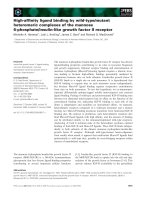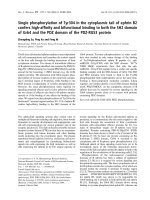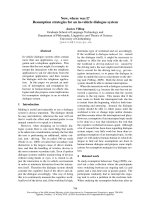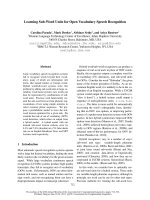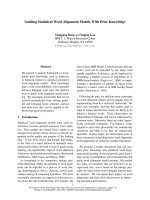Báo cáo khoa học: "High Frequency Word Entrainment in Spoken Dialogue" ppt
Bạn đang xem bản rút gọn của tài liệu. Xem và tải ngay bản đầy đủ của tài liệu tại đây (110.95 KB, 4 trang )
Proceedings of ACL-08: HLT, Short Papers (Companion Volume), pages 169–172,
Columbus, Ohio, USA, June 2008.
c
2008 Association for Computational Linguistics
High Frequency Word Entrainment in Spoken Dialogue
Ani Nenkova
Dept. of Computer and Information Science
University of Pennsylvania
Philadelphia, PA 19104, USA
Agust
´
ın Gravano
Dept. of Computer Science
Columbia University
New York, NY 10027, USA
Julia Hirschberg
Dept. of Computer Science
Columbia University
New York, NY 10027, USA
Abstract
Cognitive theories of dialogue hold that en-
trainment, the automatic alignment between
dialogue partners at many levels of linguistic
representation, is key to facilitating both pro-
duction and comprehension in dialogue. In
this paper we examine novel types of entrain-
ment in two corpora—Switchboard and the
Columbia Games corpus. We examine en-
trainment in use of high-frequency words (the
most common words in the corpus), and its as-
sociation with dialogue naturalness and flow,
as well as with task success. Our results show
that such entrainment is predictive of the per-
ceived naturalness of dialogues and is signifi-
cantly correlated with task success; in overall
interaction flow,higher degrees of entrainment
are associated with more overlaps and fewer
interruptions.
1 Introduction
When people engage in conversation, they adapt the
way they speak to their conversational partner. For
example, they often adopt a certain way of describ-
ing something based upon the way their conversa-
tional partner describes it, negotiating a common
description, particularly for items that may be un-
familiar to them (Brennan, 1996). They also alter
their amplitude, if the person they are speaking with
speaks louder than they do (Coulston et al., 2002),
or reuse syntactic constructions employed earlier in
the conversation (Reitter et al., 2006). This phe-
nomenon is known in the literature as entrainment,
accommodation, adaptation, or alignment.
There is a considerable body of literature which
posits that entrainment may be crucial to human per-
ception of dialogue success and overall quality, as
well as to participants’ evaluation of their conversa-
tional partners. Pickering and Garrod (2004) pro-
pose that the automatic alignment at many levels of
linguistic representation (lexical, syntactic and se-
mantic) is key for both production and comprehen-
sion in dialogue, and facilitates interaction. Gole-
man (2006) also claims that a key to successful com-
munication is human ability to synchronize their
communicative behavior with that of their conver-
sational partner. For example, in laboratory stud-
ies of non-verbal entrainment (mimicry of manner-
isms and facial expressions between subjects and
a confederate), Chartrand and Bargh (1999) found
not only that subjects displayed a strong uninten-
tional entrainment, but also that greater entrain-
ment/mimicry led subjects to feel that they liked the
confederate more and that the overall interaction was
progressing more smoothly. People who had a high
inclination for empathy (understanding the point of
view of the other) entrained to a greater extent than
others. Reitter et al. (2007) also found that degree of
entrainment in lexical and syntactic repetitions that
occurred in only the first five minutes of each dia-
logue significantly predicted task success in studies
of the HCRC Map Task Corpus.
In this paper we examine a novel dimension of
entrainment between conversation partners: the use
of high-frequency words, the most frequent words in
the dialogue or corpus. In Section 2 we describe ex-
periments on high-frequency word entrainment and
perceived dialogue naturalness in Switchboard dia-
169
logues. The degree of high-frequency word entrain-
ment predicts naturalness with an accuracy of 67%
over a 50% baseline. In Section 3 we discuss experi-
ments on the association of high-frequency word en-
trainment with task success and turn-taking. Results
show that degree of high-frequency word entrain-
ment is positively and significantly correlated with
task success and proportion of overlaps in these di-
alogues, and negatively and significantly correlated
with proportion of interruptions.
2 Predicting perceived naturalness
2.1 The Switchboard Corpus
The Switchboard Corpus (Godfrey et al., 1992) is
a collection of recordings of spontaneous telephone
conversations between speakers of many varieties of
American English who were asked to discuss a pre-
assigned topic from a set including favorite types of
music or the new roles of women in society. The
corpus consists of 2430 conversations with an aver-
age duration of 6 minutes, for a total of 240 hours
and three million words. The corpus has been ortho-
graphically transcribed and annotated for degree of
naturalness on Likert scales from 1 (very natural) to
5 (not natural at all).
2.2 Entrainment and perceived naturalness
Previous studies (Niederhoffer and Pennebaker,
2002) have suggested that adaptation in overall word
count as well as words of particular parts of speech,
or words associated with emotion or with various
cognitive states, can predict the degree of coordi-
nation and engagement of conversational partners.
Here, we examine conversational partners’ similar-
ity in high-frequency word usage in the Switchboard
corpus as a predictor of the hand-annotated natural-
ness scores for their conversation. Using entrain-
ment over the most frequent words in the entire cor-
pus has the advantage of avoiding sparsity problems;
we hypothesize that it will be more general and ro-
bust than attempting to measure lexical entrainment
over the high-frequency words that occur in a partic-
ular conversation.
Our measure of entrainment entr(w) is defined as
the negated absolute value of the difference between
the fraction of times a particular word w is used by
the two speakers S
1
and S
2
. More formally,
entr(w) = −
count
S
1
(w)
ALL
S
1
−
count
S
2
(w)
ALL
S
2
Here, ALL
S
i
is the number of all words ut-
tered by speaker S
i
in the given conversation, and
count
S
i
(w) is the number of times S
i
used word w.
The entr(w) statistic was computed for the 100
most common words in the entire Switchboard cor-
pus and feature selection was used to determine the
25 most predictive words used for later classifica-
tion: um, how, okay, go, I’ve, all, very, as, or, up, a,
no, more, something, from, this, what, too, got, can,
he, in, things, you, and.
The data for the experiments was a balanced set of
250 conversations rated “1” (very natural) and 250
examples of problematic conversations with ratings
of 3, 4 or 5. The accuracy of predicting the binary
naturalness (ratings of 1 or 3-5) of each conversa-
tion from a logistic regression model is 63.76%, sig-
nificantly over a 50% random baseline. This result
confirms the hypothesis that entrainment in high-
frequency word usage is a good indicator of the per-
ceived naturalness of a conversation.
Some of our 25 high-frequency words are in fact
cue phrases, which are important indicators of dia-
logue structure. This suggests that a more focused
examination of this class of words might be useful.
3 Association with task success and
dialogue flow
3.1 The Columbia Games Corpus
The Columbia Games Corpus (Benus et al., 2007) is
a collection of 12 spontaneous task-oriented dyadic
conversations elicited from native speakers of Stan-
dard American English. Subjects played a series
of computer games requiring verbal communication
between partners to achieve a common goal, ei-
ther identifying matching cards appearing on each
of their screens, or moving an object on one screen
to the same location in which it appeared on the
other, where each subject could see only their own
screen. The games were designed to encourage fre-
quent and natural conversation by engaging the sub-
jects in competitive yet collaborative tasks. For ex-
ample, players could receive points in the games in a
variety of ways and had to negotiate the best strategy
170
for matching cards; in other games, they received
more points if they could place objects in exactly
the same location. Subjects were scored on each
game and their overall score determined the addi-
tional monetary compensation they would receive.
A total of 9h 8m (∼73,800 words) of dialogue were
recorded. All files in the corpus were orthograph-
ically transcribed and words were hand-aligned by
trained annotators. A subset of the corpus was also
labeled for different types of turn-taking behavior.
These include (i) smooth turn exchanges—speaker
S
2
takes the floor after speaker S
1
has completed her
turn, with no overlap; (ii) overlaps—S
2
starts his
turn before S
1
has completely finished her turn, but
S
1
does complete her turn; (iii) interruptions—S
2
starts talking before S
1
completes her turn, and as a
result S
1
does not complete her utterance. We used
these annotations to study the association between
entrainment and turn-taking behavior.
3.2 Entrainment and task success
In the Columbia Games Corpus, we hypothesize that
the game score achieved by the participants is a good
measure of the effectiveness of the dialogue. To de-
termine the extent to which task success is related
to the degree of entrainment in high-frequency word
usage, we examined 48 dialogues. We computed the
correlation coefficient between the game score (nor-
malized by the highest achieved score for the game
type) and two different ways of quantifying the de-
gree of entrainment between the speakers (S
1
and
S
2
) in several word classes. In addition to overall
high-frequency words, we looked at two subclasses
of words often used in dialogue:
25MF-G The 25 most frequent words in the game.
25MF-C The 25 most frequent words over the entire
corpus: the, a, okay, and, of, I, on, right, is, it, that, have,
yeah, like,in, left, it’s, uh, so, top, um, bottom, with, you, to.
ACW Affirmative cue words: alright, gotcha, huh,
mm-hm, okay, right, uh-huh, yeah, yep, yes, yup. There
are 5831 instances in the corpus (7.9% of all words).
FP Filled pauses: uh, um, mm. The corpus contains
1845 instances of filled pauses (2.5% of all tokens).
We generalize our measure of word entrainment
entr(w) to each of these classes of words c:
EN TR
1
(c) =
w∈c
entr(w)
EN TR
1
ranges from 0 to −∞, with 0 meaning per-
fect match on usage of lexical items in class c. An
alternative measure of entrainment that we experi-
mented with is defined as
EN TR
2
(c) = −
w∈c
|count
S
1
(w) − count
S
2
(w)|
w∈c
(count
S
1
(w) + count
S
2
(w))
The entrainment score defined in this way ranges
from 0 to −1, with 0 meaning perfect match on lex-
ical usage and −1 meaning perfect mismatch.
The correlations between the normalized game
score and these measures of entrainment are shown
in Table 1. ENT R
1
for the 25 most frequent words,
both corpus-wide and game-specific, is highly and
significantly correlated with task success, with
stronger results for game-specific words. For the
EN T R
1
EN T R
2
Word class
cor p cor p
25MF-C 0.341 0.018 0.187 0.202
25MF-G 0.376 0.008 0.260 0.074
ACW 0.230 0.116 0.372 0.009
FP
−0.080 0.591 −0.007 0.964
Table 1: Pearson’s correlation with game score.
filled pauses class, there is essentially no correlation
between entrainment and task success, while for af-
firmative cue words there is association only under
the ENT R
2
definition of entrainment. The differ-
ence in results between ENT R
1
and ENT R
2
sug-
gests that the two measures of entrainment capture
different aspects of dialogue coordination and that
exploring various formulations of entrainment de-
serves future attention.
3.3 Dialogue coordination
The coordination of turn-taking in dialogue is espe-
cially important for successful interaction. Speech
overlaps (O), might indicate a lively, highly coor-
dinated conversation, with participants anticipating
the end of their interlocutor’s speaking turn. Smooth
switches of turns (S) with no overlapping speech
are also characteristic of good coordination, in cases
where these are not accompanied by long pauses be-
tween turns. On the other hand, interruptions (I)
and long inter-turn latency (L)—long simultaneous
pauses by the speakers— are generally perceived as
a sign of poorly coordinated dialogues.
171
To determine the relationship between entrain-
ment and dialogue coordination, we examined the
correlation between entrainment types and the pro-
portion of interruptions, smooth switches and over-
laps, for which we have manual annotations for a
subset of 12 dialogues. We also looked at the cor-
relation of entrainment with mean latency in each
dialogue. Table 2 summarizes our major findings.
cor p
EN T R
1
(25MF-C) I −0.612 0.035
EN T R
1
(25MF-G) I −0.514 0.087
EN T R
1
(ACW) O 0.636 0.026
EN T R
2
(ACW)
O 0.606 0.037
EN T R
1
(FP) O 0.750 0.005
EN T R
2
(25MF-G) O 0.605 0.037
EN T R
2
(25MF-G)
S −0.663 0.019
EN T R
2
(ACW) L −0.757 0.004
EN T R
2
(25MF-G) L −0.523 0.081
Table 2: Pearson’s correlation with proportion of over-
laps, interruptions, smooth switches, and mean latency.
The two measures that were significantly cor-
related with task success—ENT R
1
(25MF-C) and
EN T R
1
(25MF-G)—also correlated negatively with
the proportion of interruptions in the dialogue. This
finding could have important implications for the de-
velopment of spoken dialog systems (SDS). For ex-
ample, a measure of entrainment might be used to
anticipate the user’s propensity to interrupt the sys-
tem, signalling the need to change dialogue strategy.
It also suggests that if the system entrains to users it
might help to reduce such interruptions. While our
study is of association, not causality, this suggests
future areas of investigation.
Our other correlations reveal that turn exchanges
characterized by overlaps are reliably associated
with entrainment in usage of affirmative cue word,
filled pauses and game-specific most frequent
words. Long latency is negatively associated with
entrainment in affirmative cue words and game-
specific most frequent words. Overall, the more
entrainment, the more engaged the participants and
the better coordination there is between them, with
shorter latencies and more overlaps.
Unexpectedly, smooth switches correlate nega-
tively with entrainment in game-specific most fre-
quent words. This result might be confounded by the
presence of long latencies in some switches. While
smooth switches are desirable, especially in SDS,
long latencies between turns can indicate lack of co-
ordination.
4 Conclusion
We present a corpus study relating dialogue natural-
ness, success and coordination with speaker entrain-
ment on common words: most frequent words over-
all, most frequent words in a dialogue, filled pauses,
and affirmative cue words. We find that degree of
entrainment with respect to most frequent words can
distinguish dialogues rated most natural from those
rated less natural. Entrainment over classes of com-
mon words also strongly correlates with task success
and highly engaged and coordinated turn-taking be-
havior. Entrainment over corpus-wide most frequent
words significantly correlates with task success and
minimal interruptions—important goals of SDS. In
future work we will explore the consequences of
system entrainment to SDS users in helping systems
achieve these goals, and the use of simple measures
of entrainment to modify dialogue strategies in order
to decrease the occurrence of user interruptions.
Acknowledgments
This work was funded in part by NSF IIS-0307905.
References
S. Benus, A. Gravano, and J. Hirschberg. 2007.
The prosody of backchannels in American English.
ICPhS’07.
S.E. Brennan. 1996. Lexical entrainment in spontaneous
dialog. ISSD’96.
T. Chartrand and J. Bargh. 1999. The chameleon ef-
fect: the perception-behavior link and social interac-
tion. J. of Personality & Social Psych., 76(6):893–910.
R. Coulston, S. Oviatt, and C. Darves. 2002. Amplitude
convergence in children’s conversational speech with
animated personas. ICSLP’02.
J. Godfrey, E. Holliman, and J. McDaniel. 1992.
SWITCHBOARD: Telephone speech corpus for re-
search and development. ICASSP’92.
Daniel Goleman. 2006. Social Intelligence. Bantam.
K. Niederhoffer and J. Pennebaker. 2002. Linguistic
style matching in social interaction.
M. J. Pickering and S. Garrod. 2004. Toward a mecha-
nistic psychology of dialogue. Behavioral and Brain
Sciences, 27:169–226.
D. Reitter and J. Moore. 2007. Predicting success in
dialogue. ACL’07.
D. Reitter, F. Keller, and J.D. Moore. 2006. Compu-
tational Modelling of Structural Priming in Dialogue.
HLT-NAACL’06.
172
